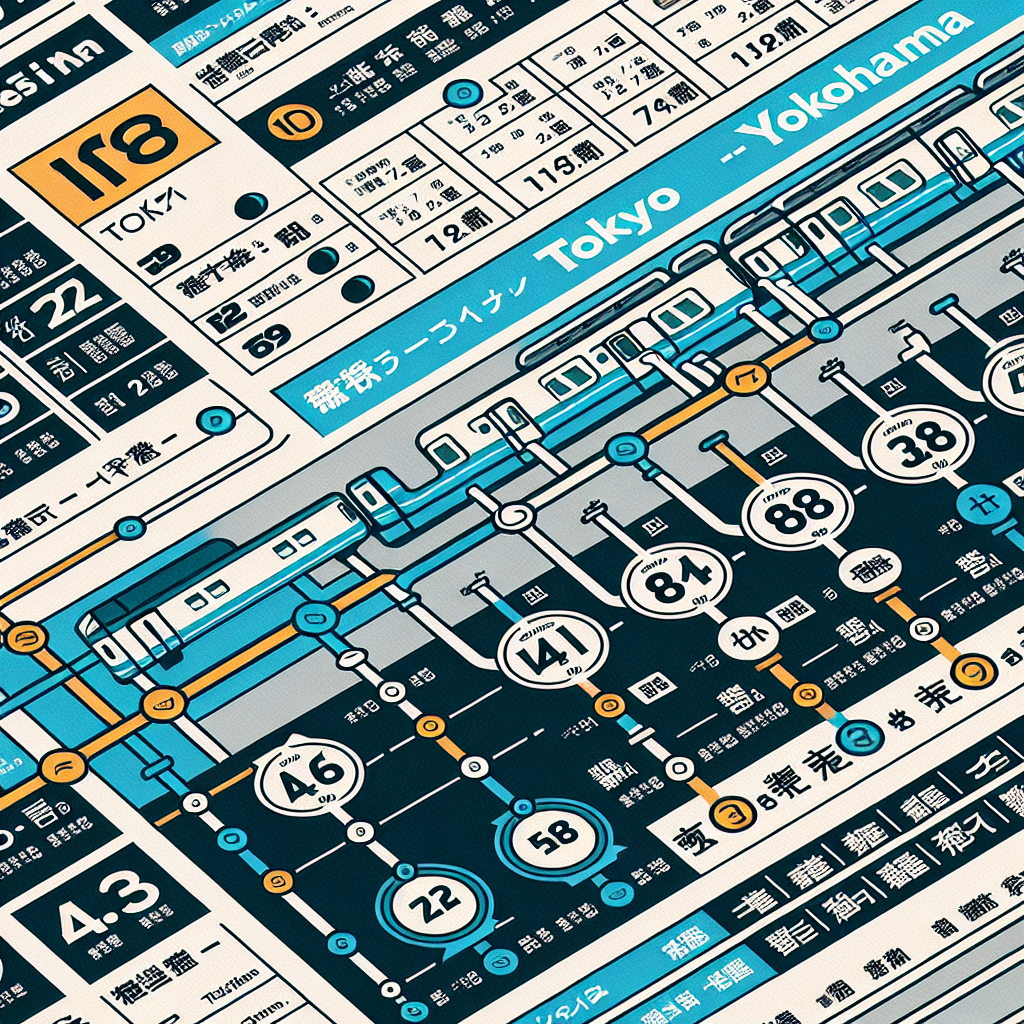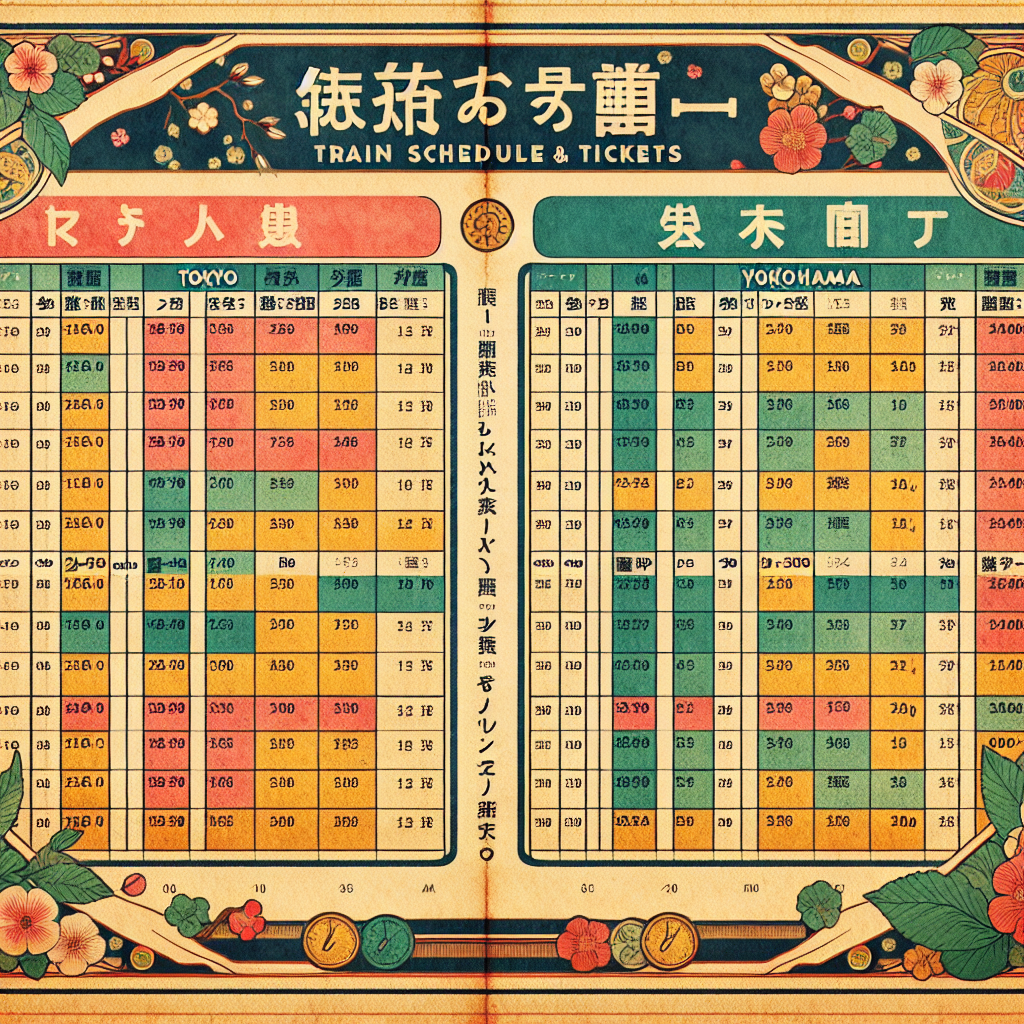“Seamless Journeys: Your Gateway from Tokyo to Yokohama Awaits!”
Introduction
The Tokyo to Yokohama train route is a vital connection between two of Japan’s most vibrant cities, offering travelers a convenient and efficient way to explore the region. With frequent services provided by various train operators, including the JR East and private lines, passengers can enjoy a swift journey that typically takes around 30 minutes. Tickets are easily accessible through ticket machines, online platforms, and at train stations, catering to both locals and tourists. Whether for business or leisure, the Tokyo to Yokohama train schedule ensures flexibility and comfort, making it an ideal choice for those looking to experience the unique attractions and culture of Yokohama.
Tokyo To Yokohama Train Schedule Overview
Traveling from Tokyo to Yokohama is a delightful experience, and understanding the train schedule can make your journey even smoother. The distance between these two vibrant cities is only about 30 kilometers, making it a popular route for both locals and tourists. Fortunately, the train services are frequent and efficient, allowing you to hop on a train at almost any time of the day.
When planning your trip, you’ll be pleased to know that the trains run regularly, with departures every few minutes during peak hours. The most convenient option is the JR Tokaido Line, which connects Tokyo Station to Yokohama Station. This line is particularly popular because it offers a direct route, and the journey typically takes around 30 minutes. If you prefer a slightly faster option, the Shinkansen, or bullet train, is also available, although it is not the most economical choice for this short distance. The Shinkansen can whisk you to Yokohama in about 20 minutes, but keep in mind that ticket prices are higher compared to the regular trains.
For those who enjoy a bit of variety, the Minato Mirai Line is another excellent choice. This line connects Yokohama’s bustling waterfront area with Tokyo’s Shibuya and Shinjuku districts. While it may take a bit longer than the JR Tokaido Line, the scenic views along the way make it a worthwhile option. Additionally, if you’re traveling during off-peak hours, you might find the trains less crowded, allowing for a more comfortable ride.
As you consider your travel time, it’s also important to factor in the frequency of the trains. During rush hours, trains can depart as often as every three to five minutes, ensuring that you won’t have to wait long for your ride. Even during quieter times, you can expect trains to run every 10 to 15 minutes. This reliability means you can easily fit your travel plans around your schedule, whether you’re heading to Yokohama for a day trip or a longer stay.
When it comes to purchasing tickets, you have several options. You can buy tickets at ticket machines or counters in the train stations, and many machines offer English language options for ease of use. If you’re planning to travel frequently on public transport, consider getting a prepaid Suica or Pasmo card. These cards can be used on most trains and buses in the Tokyo metropolitan area, making your travel seamless and hassle-free. Simply tap your card at the ticket gates, and you’re on your way!
In conclusion, the train journey from Tokyo to Yokohama is not only convenient but also an enjoyable part of your travel experience. With frequent departures, various train options, and easy ticket purchasing, you can focus on what truly matters: exploring the beautiful sights and attractions that Yokohama has to offer. Whether you’re visiting the iconic Minato Mirai skyline, indulging in delicious street food at the Cup Noodles Museum, or simply enjoying a stroll along the waterfront, the journey is just the beginning of your adventure. So, grab your ticket, hop on a train, and get ready to create unforgettable memories in Yokohama!
How To Purchase Tickets For Tokyo To Yokohama Train
When planning a trip from Tokyo to Yokohama, one of the first things you’ll want to consider is how to purchase your train tickets. Fortunately, the process is straightforward and user-friendly, making it easy for both locals and tourists to navigate. To begin with, you have several options for buying tickets, whether you prefer the convenience of technology or the traditional approach of visiting a ticket counter.
If you’re someone who enjoys the ease of online transactions, purchasing your tickets through the official JR East website or mobile app is a great choice. This method allows you to browse schedules, select your preferred train, and secure your tickets from the comfort of your home or hotel. Simply enter your departure station, destination, and travel date, and you’ll be presented with a variety of options. Once you’ve made your selection, you can pay using a credit card, and your tickets will be sent to your email or stored in the app for easy access. This option not only saves time but also helps you avoid long lines at the station.
For those who prefer a more hands-on approach, visiting a ticket vending machine at any major train station is another excellent option. These machines are available in multiple languages, including English, making it easy for international travelers to navigate the process. To purchase your ticket, simply select your departure and arrival stations, choose your train, and follow the prompts to complete your transaction. It’s worth noting that these machines accept both cash and credit cards, providing flexibility depending on your payment preference. If you ever feel uncertain about using the machines, don’t hesitate to ask a station attendant for assistance; they are usually more than happy to help.
Alternatively, if you enjoy the personal touch, you can always visit a ticket counter at the station. This option allows you to interact with staff who can provide valuable information about train schedules, ticket types, and any special deals that may be available. The staff can also help you choose the best train for your needs, whether you’re looking for the fastest option or a more scenic route. Plus, if you have any questions about your journey or need assistance with language barriers, the ticket counter is a great place to get the support you need.
Once you have your ticket in hand, it’s essential to familiarize yourself with the train schedule. Trains from Tokyo to Yokohama run frequently throughout the day, typically every 10 to 15 minutes, so you won’t have to wait long for your ride. The journey itself is relatively short, taking around 30 minutes on the express trains, which means you can easily fit this trip into your itinerary.
As you prepare for your journey, remember to check the platform information displayed on the station monitors. This will guide you to the correct platform for your train, ensuring a smooth boarding process. With your ticket purchased and your travel plans in place, you’re all set to enjoy the vibrant sights and sounds of Yokohama. Whether you’re visiting for the stunning waterfront, delicious food, or rich cultural experiences, the train ride from Tokyo to Yokohama is just the beginning of an exciting adventure. So, grab your ticket, hop on the train, and get ready to explore!
Best Times To Travel From Tokyo To Yokohama

When planning a trip from Tokyo to Yokohama, one of the most important considerations is timing. The journey itself is relatively short, typically taking around 30 minutes on the express trains, but choosing the right time to travel can significantly enhance your experience. Whether you’re heading to Yokohama for a day of sightseeing, shopping, or simply to enjoy the waterfront, understanding the best times to travel can make all the difference.
First and foremost, it’s essential to consider the peak hours of train travel. During weekdays, the morning rush hour, which generally runs from 7:30 AM to 9:30 AM, can be quite hectic. Trains are often packed with commuters heading into Tokyo for work, making it less than ideal for leisurely travelers. If you can, aim to travel outside of these peak times. Late morning, around 10 AM, is a great option as the trains are less crowded, allowing you to enjoy a more comfortable ride. Additionally, this timing gives you a chance to explore Yokohama without the hustle and bustle of the early crowd.
Similarly, the evening rush hour, typically from 5 PM to 7 PM, can be quite busy as well. If you plan to return to Tokyo after a day in Yokohama, consider leaving after 7 PM. This way, you can avoid the crowds and enjoy a more relaxed journey back. Plus, traveling later in the evening allows you to experience Yokohama’s vibrant nightlife, with its stunning illuminated skyline and lively dining scene.
Another factor to consider is the day of the week. Weekends can be particularly busy, especially if there are special events or festivals happening in Yokohama. If you’re looking to avoid the crowds, consider visiting on a weekday. However, if you’re interested in experiencing local events or markets, weekends might be the perfect time for you. Just be sure to check the local calendar for any special happenings that might draw larger crowds.
In addition to timing your travel around peak hours and weekdays versus weekends, it’s also wise to keep an eye on the weather. Yokohama is known for its beautiful waterfront and outdoor attractions, so if you’re planning to explore places like Yamashita Park or the Red Brick Warehouse, a sunny day will enhance your experience. Conversely, rainy days might lead you to indoor attractions such as the Cup Noodles Museum or the Yokohama Museum of Art. Checking the weather forecast ahead of your trip can help you plan your day accordingly.
Lastly, purchasing your train tickets in advance can save you time and ensure a smoother journey. While you can buy tickets at the station, using an app or website to secure your tickets ahead of time can help you avoid any last-minute stress. Many services offer mobile tickets, which can be scanned directly from your phone, making the process even more convenient.
In conclusion, the best times to travel from Tokyo to Yokohama hinge on a combination of avoiding peak hours, considering the day of the week, and being mindful of the weather. By planning your trip with these factors in mind, you can enjoy a seamless and enjoyable journey, allowing you to focus on the wonderful experiences that await you in Yokohama. So, pack your bags, grab your tickets, and get ready for an adventure that’s just a short train ride away!
Comparing Train Options: Shinkansen vs. Local Trains
When planning a trip from Tokyo to Yokohama, one of the first decisions you’ll face is choosing the right train option. The journey, which is only about 30 minutes, offers a couple of distinct choices: the Shinkansen, Japan’s famous bullet train, and the local trains that connect these two bustling cities. Each option has its own unique advantages, making it essential to consider your priorities before making a decision.
Starting with the Shinkansen, this high-speed train is renowned for its efficiency and comfort. If you’re in a hurry or simply want to experience the thrill of riding one of the fastest trains in the world, the Shinkansen is an excellent choice. With trains departing frequently throughout the day, you can easily find a schedule that fits your itinerary. The ride itself is smooth and quiet, allowing you to relax and enjoy the scenery as you zip past the urban landscape. However, it’s worth noting that the Shinkansen is generally more expensive than local trains, so if you’re traveling on a budget, this might not be the best option for you.
On the other hand, local trains provide a more economical way to travel between Tokyo and Yokohama. The journey may take a bit longer, typically around 40 to 50 minutes, but local trains offer a unique opportunity to experience everyday life in Japan. As you ride, you’ll likely encounter a mix of commuters, students, and tourists, all of whom contribute to the vibrant atmosphere. Additionally, local trains often make more stops, allowing you to catch glimpses of neighborhoods and attractions that you might otherwise miss. This can be particularly appealing if you’re interested in exploring areas beyond the main tourist spots.
Another factor to consider is the frequency of departures. Both the Shinkansen and local trains run regularly, but local trains tend to have a more extensive schedule, especially during peak hours. This means you won’t have to wait long for the next train, making it a convenient option if you’re looking to be spontaneous with your travel plans. Moreover, if you’re using a Japan Rail Pass, local trains are typically included, which can help you save money while still enjoying the journey.
When it comes to comfort, the Shinkansen undoubtedly takes the lead. With spacious seating, ample legroom, and onboard amenities like food and beverage service, it’s designed for a pleasant travel experience. In contrast, local trains can be more crowded, especially during rush hour, which might make for a less comfortable ride. However, many local trains also offer comfortable seating, and some even have designated areas for luggage, making them a viable option for travelers with bags.
Ultimately, the choice between the Shinkansen and local trains comes down to your personal preferences and travel needs. If speed and comfort are your top priorities, the Shinkansen is hard to beat. However, if you’re looking for a more budget-friendly option that allows you to soak in the local culture, local trains are a fantastic alternative. Whichever option you choose, the journey from Tokyo to Yokohama promises to be an enjoyable experience, filled with the excitement of exploring two of Japan’s most dynamic cities. So, grab your ticket, sit back, and enjoy the ride!
Tips For Navigating Tokyo To Yokohama Train Stations
Traveling from Tokyo to Yokohama is a delightful experience, and navigating the train stations can be a breeze with a few handy tips. First and foremost, familiarize yourself with the train lines that connect these two vibrant cities. The most popular option is the JR Tokaido Line, which offers frequent services and takes about 30 minutes to reach Yokohama. Alternatively, the Minato Mirai Line provides a scenic route, especially if you’re heading to the waterfront area. Knowing your options will help you choose the best route based on your schedule and interests.
Once you’ve decided on your train line, it’s essential to understand the layout of the stations. Tokyo Station, one of the busiest in the world, can be overwhelming at first glance. However, it’s well-signposted in both Japanese and English, making it easier for travelers to find their way. As you enter the station, take a moment to locate the information desks, where friendly staff can assist you with any questions. Additionally, many stations have maps available, which can be incredibly helpful in planning your journey.
When you arrive at Yokohama Station, you’ll notice that it’s more compact than Tokyo Station, but it still offers a variety of amenities. From shops to restaurants, you’ll find everything you need to make your visit enjoyable. If you’re planning to explore the city, consider purchasing a prepaid Suica or Pasmo card. These cards not only simplify the ticketing process but also allow you to hop on and off various trains and buses without the hassle of buying individual tickets each time.
As you navigate the stations, keep an eye on the electronic boards displaying train schedules. These boards provide real-time updates on train arrivals and departures, ensuring you’re always informed about any changes. If you’re traveling during peak hours, be prepared for crowded trains, especially on weekdays. It’s a good idea to travel during off-peak times if you prefer a more comfortable experience. However, if you do find yourself in a crowded carriage, don’t worry; it’s all part of the Tokyo experience!
Another tip for a smooth journey is to download a navigation app on your smartphone. Apps like Google Maps or Hyperdia can help you plan your route, check train schedules, and even provide platform information. This can be particularly useful if you’re unfamiliar with the area or if you’re traveling with a group. Additionally, many apps offer English language support, making it easier for non-Japanese speakers to navigate the system.
Lastly, don’t forget to enjoy the journey itself. The train ride from Tokyo to Yokohama offers glimpses of the city’s skyline and the beautiful waterfront, so be sure to have your camera ready. Once you arrive in Yokohama, take a moment to soak in the atmosphere before diving into your itinerary. Whether you’re visiting the iconic Minato Mirai district or exploring the historic Chinatown, the journey from Tokyo to Yokohama is just the beginning of an unforgettable adventure.
In conclusion, navigating the train stations between Tokyo and Yokohama can be a straightforward and enjoyable experience with a little preparation. By familiarizing yourself with the train lines, utilizing available resources, and embracing the journey, you’ll find that traveling between these two cities is not only convenient but also a wonderful way to experience the unique charm of Japan. So grab your ticket, hop on the train, and get ready for an exciting day in Yokohama!
Understanding Train Fare Differences Between Tokyo And Yokohama
When planning a trip from Tokyo to Yokohama, one of the first things that comes to mind is the train fare. Understanding the differences in train fares between these two bustling cities can help you budget your travel more effectively and make the most of your journey. The distance between Tokyo and Yokohama is relatively short, approximately 30 kilometers, which means that train travel is not only convenient but also quite affordable. However, the fare can vary depending on the type of train you choose, so let’s delve into the details.
First and foremost, it’s essential to know that there are several train services operating between Tokyo and Yokohama. The most popular options include the JR Tokaido Line, the JR Shonan-Shinjuku Line, and the Yokohama Line. Each of these services offers different levels of comfort and speed, which in turn affects the fare. For instance, the JR Tokaido Line is known for its rapid service, making it a favorite among commuters and travelers alike. The fare for this line typically ranges from around 480 to 600 yen, depending on whether you opt for a local or rapid train. This makes it an economical choice for those looking to travel quickly without breaking the bank.
On the other hand, if you prefer a more leisurely journey, you might consider taking the Yokohama Line. While it may take a bit longer to reach your destination, the fare is quite similar, usually hovering around the same price range as the Tokaido Line. This option allows you to enjoy the scenic views along the way, making your travel experience more enjoyable. Additionally, if you’re traveling during off-peak hours, you might find that the trains are less crowded, providing a more comfortable ride.
Another factor to consider is the type of ticket you purchase. For instance, if you plan to make multiple trips or explore other areas around Yokohama, a prepaid Suica or Pasmo card can be a great investment. These cards not only save you time at ticket machines but also offer a slight discount on fares compared to single-journey tickets. Plus, they can be used on various forms of public transportation, including buses and subways, making them incredibly versatile for your travel needs.
Moreover, it’s worth noting that some train services offer special discounts or passes for tourists. For example, the JR East Pass allows unlimited travel on certain lines for a set number of days, which can be a fantastic deal if you plan to explore beyond just Tokyo and Yokohama. This option can significantly reduce your overall travel costs, especially if you’re planning to visit multiple destinations in the region.
In conclusion, understanding the fare differences between train services from Tokyo to Yokohama is crucial for making informed travel decisions. By considering factors such as the type of train, ticket options, and potential discounts, you can ensure that your journey is not only enjoyable but also budget-friendly. Whether you choose the rapid service of the Tokaido Line or the scenic route of the Yokohama Line, you’re bound to have a delightful experience as you travel between these two vibrant cities. So, pack your bags, grab your ticket, and get ready to explore the wonders that await you in Yokohama!
Conclusion
The train schedule between Tokyo and Yokohama is frequent and efficient, with multiple options available throughout the day, including the JR Tokaido Line and the Yokosuka Line. Tickets can be easily purchased at stations, online, or via mobile apps, with prices typically ranging from 500 to 600 yen for a one-way trip. Overall, traveling between these two cities is convenient and accessible, making it a popular choice for both commuters and tourists.


